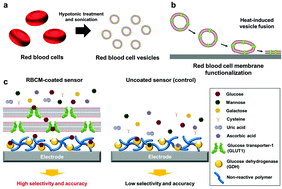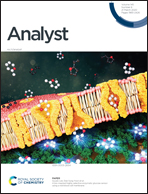A bio-inspired highly selective enzymatic glucose sensor using a red blood cell membrane†
Abstract
In the development of enzymatic glucose sensors, accurate glucose sensing has been a challenging task because of the existence of numerous interfering molecules in the blood. Meanwhile, red blood cells (RBCs) selectively uptake glucose via a membrane protein called glucose transporter-1. In this study, we developed the RBC membrane (RBCM)-coated enzymatic glucose sensors that mimic the glucose uptake. The RBCM-coated sensors were examined via scanning electron microscopy, atomic force microscopy, and ATR-FTIR. We optimized the glucose permeability of the RBCM filter by controlling the thickness of the filter. The sensing range of the optimized sensor was 1–15 mM, the detection limit was 0.66 mM, and the sensitivity was 2.978 μA mM−1. Intriguingly, the RBCM-coated sensor was highly accurate and precise, despite the coexistence of glucose and interfering molecules (e.g., mannose, galactose, ascorbic acid, uric acid, and cysteine). For each interfering molecule, the errors of our sensor were 0.8 to 2.3%, which was 4.8–14.2 times more accurate than the uncoated one. A similar result was verified for a human serum sample containing countless interfering molecules. Also, the sensing performance of the sensor was consistent after 4 weeks of storage. The results suggest that applying RBCM may improve the selectivity of various types of glucose sensors including the continuous monitoring system.



 Please wait while we load your content...
Please wait while we load your content...